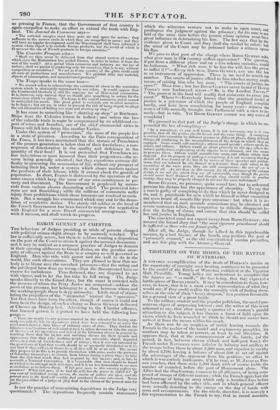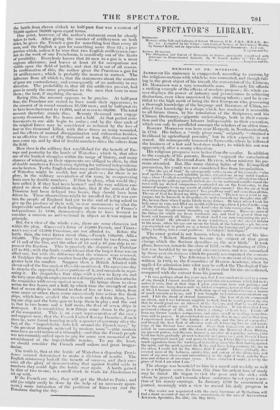THOUGHTS ON THE MODEL OF THE BATTLE OF WATERLOO.
A Norsins,. exemplification of the truth of Honsees maxim on the superiority of eyesight over hearing., continues to be presented by the model of the. Battle of NVaterloo, exhibited at the Egyptian Hall, Piccadilly. Young ladies are understood to complaia that the figures are " so small ;" the ftet being, that they expected a battle-piece of BouansxoNes. It May be consolation to them, how- ever, to know, that it is a most exact representation of what they would see, if they could realize the romantic wish of finding them- selves at the side of their " heavy dragoon," in a position favourable for a general view of a great battle. To the military student and the popular politician, the model pre- sents an object of surpassing interest ; and the writer of this is not ashamed to say, that after nearly a quarter of a century's painful attraction to the subject, it has thrown a burst of light upon his views, which he feels wounded to think he should not sooner have arrived at front the means within his reach.
As there can be no suspicion of unthir leaning towards the French in the author of the model and explanatory pamphlet, his numbers may be taken as correct, at least in one direction. It appears then, that at the commencement of the battle, (of the period, in fact, between eleven o'clock and half-past four,) the French under N. pot.EoN \me inferiiir in intitntry and artillery to time troops befbre them by about 2,200 men, and superior in cavalry by about 2,700, leaving a balance of about 500 to set oil' against the advantages of the opponent from his position ; an effect to which it was entirely inadequate, it' it be true, as M. JACQUES PHI- SON vouches, that there were 1,500 dead, with of course treble the number of wounded, before the post of liougomont alone. The Allies had the disadvantage common to all alliances, of being com-
posed of troops of different nations ; while the French again had the disadvantage of being au army which only a hundred days before had been officered by the other side, and in which general officers were actually deserting to the enemy on the day of battle with arms and accoutrements. On the whole, therefore, it is scarcely a fair representation to the French to say, that in round numbers,
the battle from eleven o'clock to half-past four was a contest of 70,000 against 70,000 upon equal terms.
One point., however, of the author's statement must be closely taken to task. After giving the number of artillerymen on both sides, he gives the French a gun for something less than every 26 men, and the English i a gun for something more than 52 ; a pro- portion which, unless t be true that two English artillerymen can-
not do the work of one Frenchman, is manitbstly out of the limits of possibility. Everybody knows that 26 men to a gun is a most copious allowance, and leaves at least 10 for occupations not visible upon the field of battle; and that 52 is out of all reason. In confirmation of this, the author gives the Prussians a gun thr 19 artillerymen ; which is probably the nearest to correct. The inference from all which is, that the statements about the number of guns arc contradictory, and consequently of no authority in any direction. The probability is, that all the artilleries present, had guns in nearly the same proportion to the men that were to man them; the best, if anything, the most. Saving this, the account appeals to be precise. At half-past four, the Prussians are stated to have made their appearance, to the amount Of in round numbers 16,.500 men ; and by half-past six
to have been increased to 44,000, and at seven to 50,000. The total account theretbre stands thus. Seventy thousand men engage seventy thousand, for five hours and a half At that period rein- forcements to one side begin to arrive; and by the time each of the original forces may be considered as reduced by the loss of four or five thousand killed, with three times as ninny wounded, and the effects of mutual disorganization and exhaustion besides, to an effeetive force of fifty thousand or less, fifty thousand new men come up, and by dint of double numbers drive the others from the field.
Here then is the military tact established for the benefit of Eu- rope and posterity by the battle of Waterloo; which is, that after one of the hardest struggles within the range of history, and many chances of winning, as their opponents arc obliged to allow, by dint of double numbers a French army- fighting for national independence can be beaten. To the English aristocracy and its retainers, the battle of Waterloo might be useful, but not &oleos ; for there is no glory, in the military acceptation of the term, in overpowering brave men by double numbers. If that be glory, what would they have called it if they had been beaten ? and the very soldiers em- ployed to show the exhibition declare, that if the arrival of the Prussians had been delayed two hours, they should have been driven in. These observations might be uncalled for, ir it was cer- tain the people of England had got to the cud of being asked to give up the produce of their toil, to rear monuments to what the irrepressible outburst of their feelings on the recovery of France's independence him 1830, demonstrates them to have learned to consider a success as anti-national in object as it was unjust in principle.
But, for a view of the whole case, there arc some elements not within the plan. CROnellY'S three of 40,000 French, and Tom:
MAN'S corps of 1:5,000 Prussians, are not alluded to. Before the battle then, the total forces stood thus,—French 110,000, Allies 13i3,000. The proportions may be represented by two fleets, one of 11 sail of the line, and the other of 13 and a 40 gun ship to re-
present the fraction. This is precisely the disparity at Trafalgar (27 to 33) ; with the rustle r coincidence that the larger three was an allied one, but with the difference that the winners were reversed. At Trafidgar the smaller number beat the greater ; at Waterloo the
greater beat the smaller. Suppose then a British Admiral with eleven sail of the line lig:Mist the odds mentioned. On a previous day he attacks the opposing fleet or portions or it, and succeeds in sepa- rating it. lie despatches four Ship:: \yid' a view to keep six and the forty-gun ship in employment at a distant point ; and then attacks the remainder with seven against seven. Ile brings them to close action for five hours and a half, by which time the strength of each fleet of seven ships is reduced to that of five or less ; when, from some cause or other, there come successively into action five fresh ships, which have evaded the vessels sent to detain them, leav- ing one ship and the liirty-gun to keep them in play ; and the end is, that in two hours and a half intim, the fleet of seven ships is destroyed. It is astonishing Imw things come down in the grasp of the columnist. This is an exact representation of the case ; and suppose now, that the French United Service Gazettes, if such there be, were found boasting m arly a quarter of a century after the fact, of the "imperishable halo left around the French navy," by "the greatest triumph achieved by modern arms"—(the modem arms have an odd notion of a triumph)—and that the French people was interminably called upon to pay for some new memorial of its astonishment at the imperishable wonder. To say the least, we should consider the French small sailors and great bragga- docios.
The truth is, that at the battle of Waterloo a disposing Provi- dence seemed determined to make a division of results. 'Ile
English aristocracy had all the benefit of success, and their ene- mies all the glory of demonstrating that against fearful odds in numbers they could light the battle over again. A battle gained by dint of two to one, is a small stock in trade fur Absolutism to set up with. If the French arc wise, they will get the Model to Paris ; and add (as might easily be done by the help of an accessory apart- ment,) some intimation of the positions of Coot-coy and the
Prussians during the day. 0



























 Previous page
Previous page